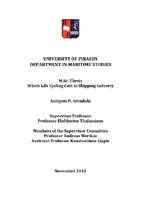| dc.description.abstractEN | The main purpose of the thesis is to introduce the notion of costs during the ship's life (Life Cycle Costs-LCC) and the total cost for the entire ship's life (Whole Life Costing-WLC) for the valuation of the investment in various ship types.
For operation of the ship there are specific cost. More specifically, we have operating costs (Operating Cost) and travel costs (Voyage Cost). Assuming, the ship is under long-term charter, where the travel cost burden the charterer; we manage to eliminate one parameter, which cannot be measure. So we have only the operating costs that are measurable. If you enter the construction costs, the reselling value and the cost of scrap, we have all the elements for the measurement of total costs during the ship's life (Life Cycle Costs-LCC).
In addition, if you enter and financing costs, income from the operation of the ship and several other cost factors extrinsic to the operation of the ship, we managed to gather all the parameters for measuring the total costs over the lifetime of the ship (Whole Life Costing).
The ship is of tangible item, with a limited life and with characteristics similar to the real estate market. In the sector of real estate market had been applied research methodologies of LCC and WLC. Based on these studies, will test the effectiveness of these methodologies in the shipping industry for ships in liquid and dry cargo, gathering information on all the above variables. Finally, we will proceed to create various scenarios to evaluate an investment based on the model we will construct.
More specifically, this work consists of five main parts. The first part deals with existing literature on the object we are examining. In the second part, we do an analysis of the shipping market. In the third part we present the information used to conduct the conclusions and analyzed the methodology that followed. Regarding the methodology we follow a model of Liapis et. al(2013), which had been applied only to the building industry so far. We analyzed all the possible parameters and customize it so that it is applicable to vessels as well. The next and most important step of this work was the appliance of the model we constructed in all the Bulk Carriers and Tanker vessels and the results of this analysis. In more detail, we build tree models for each ship category. We took an operation period of ten years, from 2000 to 2009 and we assume that in 1.1.2010 we resale the ship. In the tree models we construct
Whole Life Cycling Cost in Shipping Industry we took tree cases. In the first case the ship-owner is buying a new building vessel and operates for the examined period and in the end of this period he resale the vessel reaping profits. In the second case the ship owner is buying a five-year-old second hand vessel, which operates it for the exactly same period and then he resale it. In the third case the ship-owner for the same period buys a fifteen-year-old second hand vessel and in the end of the period he sales the vessel in the demolition market, in other words the ship goes for scrap. The results of these models varied depending on the ship type, which examined each time and the market the ship actives.
More generally comparing the two markets, the market of the bulk carries is being affected more by the economic cycles than the tankers market. The tankers market is determined more by the mayor oil companies. | el |



